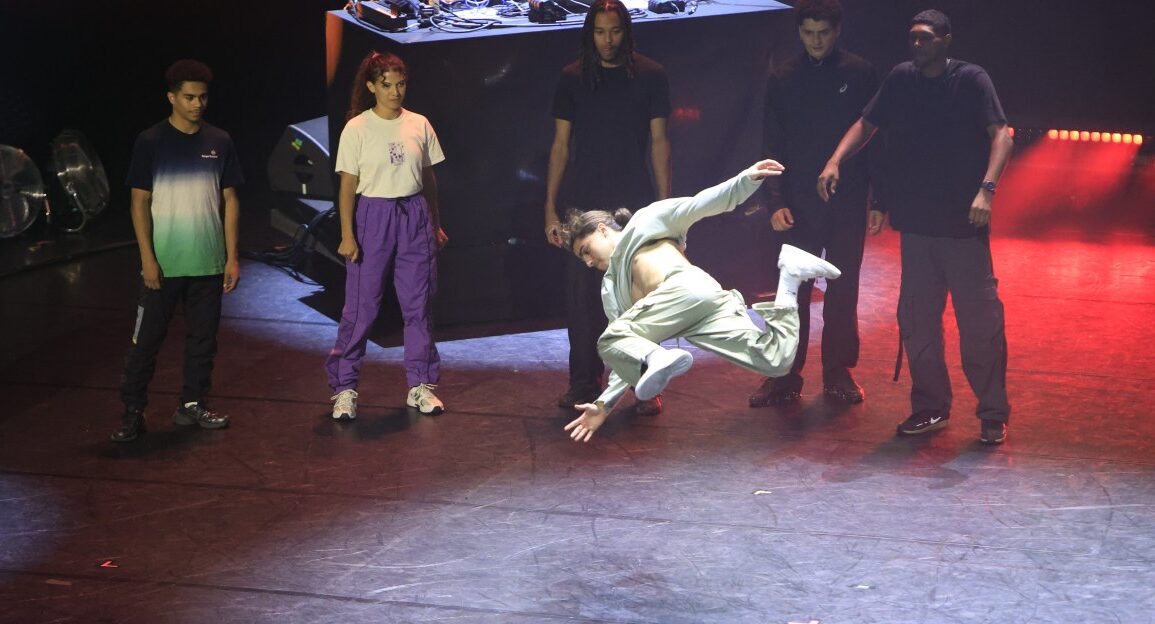At last, the B-boys of summer — and B-girls — are here, and they’re bringing their unique blend of dancing, gymnastics, and hip-hop culture to Paris. On August 9, breaking — don’t call it breakdancing — makes its hotly anticipated Olympics debut in the sport’s highest-profile moment to date.
The entrance of breaking into the Olympics is a huge milestone for a sport and a dance style that has fought long and hard for social acceptance. After all, you don’t get to be an Olympic athlete without approaching a mindblowing level of physical stamina and ability. And when you match that with the level of agility required of great dancers, plus the heady competitiveness of a sport that was honed through street battles, you have the recipe for a truly unique, groundbreaking Olympic sport — and the mainstreaming of this American-born street dance on a whole new global level.
What is breaking?
To understand breaking, you have to understand the roots of hip-hop culture. On the sidewalks and back yards of the Bronx, where hip-hop was born in the late ’60s and ’70s, there were four main streams, or elements, of hip-hop artistry: DJ-ing, emceeing, graffiti art, and breaking. All of them evolved into cornerstones of contemporary mainstream culture. DJing is everywhere, from your average wedding to the megastars who play clubs and arenas, and has evolved further into producers who develop beats and sounds. Emceeing became more commonly known as rapping, which has evolved further into a varied and rich poetic language. Graffiti influenced modern art and pop aesthetics for decades and influenced “guerilla” art and other subversive underground art movements. It’s now a regular installation in museums and galleries and a crucial element of public art in urban areas. And breaking, growing alongside other related but individual street dance styles, became one of the most famous and popular dance forms around.
Over the decades, breaking and other street dance styles have benefited from popular dance media like the Step Up franchise, K-pop and other popular Asian dance groups, and shows like Street Dance of China. Simultaneously, the rise of high-profile international street dance circuit competitions like Juste Debout and Red Bull’s annual BC One challenge have sent breaking and its associated culture on an ascendant trajectory that shows no signs of stopping.
Breaking is a unique blend of athleticism and artistry
When a B-boy or B-girl wants to be taken seriously as a breaker, they have to show not only that they can do big athletic movements, but that they can also execute precise “toprock,” the basic steps for opening and transitioning a dance into the more athletic movements — because the beat is still essential to the performance. In a toprock battle, like the one shown below, bigger movements don’t always win out over controlled musicality.
Outside of a special toprock competition like this one, the purpose of toprock is to help the dancer get smoothly to the floor, where the bigger, more gymnastic moves usually happen. But that wasn’t always the case; in a 2020 interview, OG hip-hop pioneer DJ EZ Mike explained that breaking evolved over time into the big movements it’s known for today:
The dance changed as the years went on. We didn’t do windmills on the floor because we didn’t dirty our clothes. We dressed very nice. So it had a lot to do with hand movements, facial gestures and footwork. I guess they call it Up-Rocking today.
As dancers got more comfortable getting down and dirty, the form of breaking expanded. In this classic breaking footage from 1984, the street dance crew Sidewalk Breakers demonstrate a variety of moves that show how complex footwork flows to complex floor work:
That’s where the most well-known breaking moves come from — like the “Thomas Flair,” a famous gymnast move that evolved into an even more famous old-school breaking move where a dancer whirls around while balancing on one or two hands…
…or the “Windmill,” which is essentially the same thing upside down, with the dancer balancing on their elbows and shoulders and occasionally just their head.
Obviously some of these big “power moves” are extremely dangerous, which is one reason why breaking has fought for decades to overcome what was initially a negative reputation. Part of this was due to the overall stigmatization of hip-hop culture by the mainstream, and the racist stereotype that it was inherently tied to gang participation. In fact, the four “elements” of hip-hop were first brought together as a way for gangs in the Bronx to unify and interact peacefully in block parties and other collective forms of community-building. They gave rise to dance crews, which are still a staple of street dance culture. Street dance is inherently both collective and competitive, so you’re always strongest when you’re part of a strong team of dancers.
Another reason for breaking’s negative public perception was due to the media-coined moniker “breakdancing” itself (which arose thanks to a flub from the manager of the legendary Rock Steady crew during an interview), and the danger and risk of injury it implied. Within the culture, the name “breaking” actually came from participants responding to breaks in the music — that is, filling the parts we now think of as “dance breaks” with, what else? Dancing. Originally, breaking was purely for fun, improvised during block parties. This led to the “cypher,” or dance groups in which the participants form a circle — an informal stage — and take turns dancing for one another. Eventually, the cypher spawned a more structured form of competition — the “battle” — that still dominates street dance culture.
As we can see from the first video above, the battle format is usually pretty simple. Two competitors improvise, or “freestyle,” dance moves to songs chosen on the spot by the DJ and administered by an emcee. They usually compete in two rounds, after which the judges declare the winner. The judges are nearly always on stage or next to the stage with the competitors, and in most settings they vote in the most informal way possible — by deciding then and there, pointing at whoever won.
In a case where the judges can’t decide, they’ll form an “X” with their hands, indicating that the dancers need to perform one more round. In some cases, “one more round” can turn into multiple rounds and become a test of stamina. This is a big deal for breakers, who are known less for their stamina over long battles than for their huge bursts of physical activity.
There are, of course, variants of one-on-one battles, like two-on-two battles, or team battles. The most famous team battle is probably the “7 to Smoke,” a ruthless battle format in which contestants who win one round keep battling other competitors in succession until they lose and the new winner takes over battling. This continues either until 25 minutes have elapsed overall, with the winner being the person who’s won the most rounds, or until one person has managed to win seven rounds.
These are the basics of breaking. But of course, for the Olympics, things are a little more complicated.
What you can expect at the Olympics
Throughout the 2010s, an Olympics dance lobby known as the World DanceSport Federation worked hard to raise awareness of breaking as a dance style and advocate for its entrance into the Olympics. (They adopted breaking as their main cause after failing to get ballroom dancing accepted into the games — a big pivot, but one that paid off.) In 2016, they scored big when breaking made its debut in the 2018 Youth Olympic Games. It was widely seen as a precursor to the Olympics stage, and the official Olympics website hailed the games as showcasing breaking as “a truly global sport.”
You might expect the Olympics to completely change the way that breaking battles are conducted, but surprisingly, they’ve only slightly tweaked the basic battle concept. At Paris, we’ll see 16 men and 17 women go through essentially two major rounds of competition. (Because the women’s competition has an odd number of participants, the two lowest-seeded women contestants will first have their own one-off round to choose which will join the rest of the competition.)
The first round for both men and women will be an all-encompassing round robin battle with contestants randomly divided into four groups of four. Each competitor will then battle against the other three in a two-round battle.
After they’ve all battled against one another, each group’s two highest-scoring contestants will advance to the next three rounds of competition, where they’ll be weeded out in one-on-one battles of three rounds each. The last breaker standing — or windmilling — gets the gold.
The format is only slightly different from standard battles, and the most important element — improvisation — remains. No pre-rehearsed routines here; the breakers will still be showing off their ability to adapt to songs they haven’t prepared for in advance. The judging will necessarily be more formal. Judges will vote after each round based on six criteria. As with ice skating, some factors carry more weight than others, but surprisingly, it’s not a “technical/artistic” split: technique, performativity, and creativity comprise 60 percent of the score; personality, variety, and musicality comprise 40 percent. (“Performativity” in this context refers to how cleanly moves are executed.)
Contestants to keep your eye on include Afghani IOC Refugee team member Manizha Talash, who won hearts with her inspiring story of discovering and then rediscovering breaking across two continents. At 42, veteran Japanese dancer Fukushima Ayumi faces a much younger crop of dancers, many of whom are still in their teens and just started dancing a few years ago. She could also face her own teammate, Yuasa Ami, with whom she’s had a fierce back-and-forth rivalry. She defeated Ami in the 2021 world championships; Ami then won the 2022 world prize, only for Ayumi to return with a vengeance in the 2024 Olympic Qualifier.
On the men’s side, Vancouver-based frontrunner Philip Kim, aka Phil Wizard, has a knack for pulling off miracles — he decided to enter a cypher competition in Los Angeles, vowing to quit college and pursue breaking full-time if he won. He did. His main competition? Probably Japan’s Nakarai Shigeyuki, aka Shigekix, known for big, crowd-thrilling dance moves. For a preview of how that showdown might play out, here they both are, facing off last year:
As exciting and fresh as all of this is, these games and these contestants still have a lot to prove to skeptics and Olympic officials alike. “Dance is not a sport. It’s an art, no matter what the International Olympic Committee or So You Think You Can Dance judges try to tell you,” opined one columnist in 2022. “Including dance seems like a desperate reach for more viewership.” As Fortune recently noted, breaking has yet to be approved for the 2028 Olympics in Los Angeles — despite the city being a hotbed of street dance culture and a regular stop on battle competition circuits.
If there’s anything we know about breakers, however, it’s that they know how to put on big, dramatic shows. The Olympics may indeed be experimenting to bring in more viewers, but this year’s breakers will make the gamble worth it — and hopefully leave them with plenty to look forward to in four more years.
This post was originally published on this site be sure to check out more of their content.





